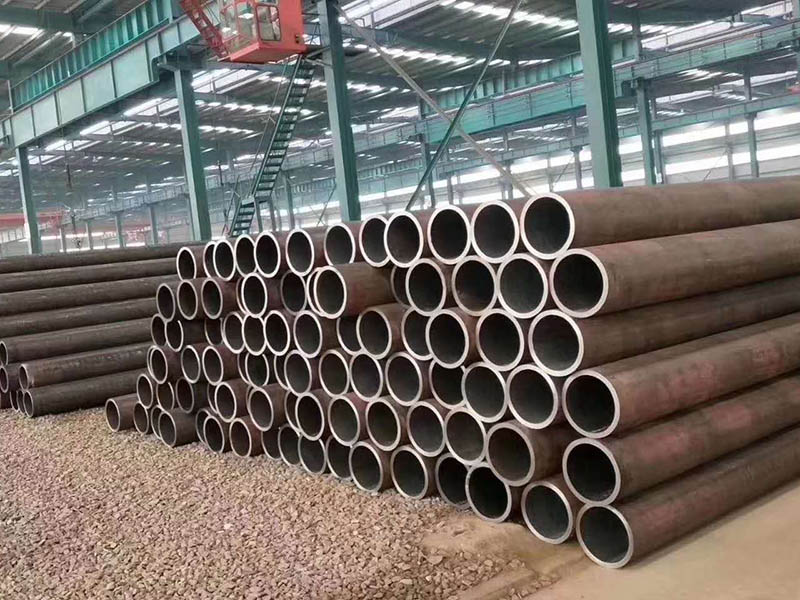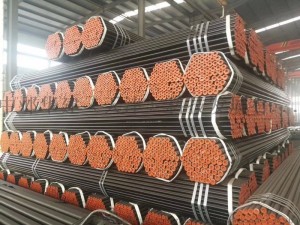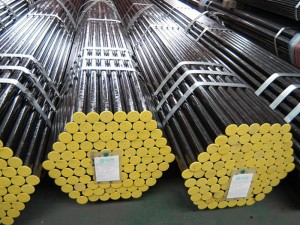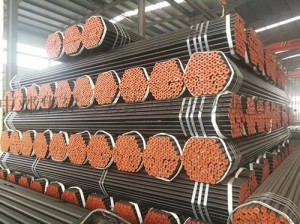A333GR.6 A106C ST52 A213 T22 ST35 seamless steel pipe
S355J2 shall comply with en10025-2:2004( Old standard (en10025:1990)
C: ≤0.22; Si: ≤0.55; Mn: ≤1.60; P: ≤0.025; S: ≤0.025; Cu: ≤0.55;
-20℃: ≥27。
(Mpa): ≤16mm: ≥355: 16—40: ≥345; 40—63: ≥335; 63—80: ≥325;
80—100: ≥315; 100—150: 295; 150—200: ≥285; 200—250: ≥275; 250—400:≥265。

S355jo is a European standard hot rolled structural steel product.
S355jo implements the standard en10025-2:2004 (Old standard (en10025:1990)
The quenching temperature of low-temperature steel pipe is A3 + (30 ~ 50) ℃. In practice, the upper limit is generally taken. Higher quenching temperature can accelerate the heating speed of low-temperature steel pipe, reduce surface oxidation and improve work efficiency. In order to homogenize the austenite of the workpiece, sufficient holding time is required. If the actual furnace loading is large, the holding time needs to be extended appropriately. Otherwise, insufficient hardness may occur due to uneven heating. However, if the holding time is too long, the disadvantages of coarse grain and serious oxidation decarburization will also appear, which will affect the quenching quality. We believe that if the charging amount is greater than that specified in the process documents, the heating and holding time needs to be extended by 1 / 5.
Because the hardenability of low-temperature steel pipe is low, 10% brine solution with high cooling rate shall be used. The workpiece should be quenched thoroughly after entering the water, but not cold thoroughly. If 45# precision steel pipe is cooled thoroughly in salt water, the workpiece may crack, which is caused by the rapid transformation of austenite into martensite when the workpiece is cooled to about 180 ℃, resulting in excessive structural stress. Therefore, when the quenched low-temperature steel pipe is rapidly cooled to this temperature area, the slow cooling method should be adopted. Since the outlet water temperature is difficult to master, it must be operated by experience. When the shaking of the workpiece in the water stops, the outlet water can be air cooled (oil cooling is better). In addition, the workpiece should move rather than static when entering the water, and make regular movement according to the geometry of the workpiece. Static cooling medium and static workpiece lead to uneven hardness and stress, resulting in large deformation and even cracking of workpiece.
The quenched hardness of low-temperature steel pipe quenched and tempered parts should reach hrc56 ~ 59, and the possibility of large section is lower, but it should not be lower than hrc48. Otherwise, it means that the workpiece has not been completely quenched, and sorbite or even ferrite structure may appear in the structure. This structure is still retained in the matrix through tempering, which can not achieve the purpose of quenching and tempering.
For the high-temperature tempering of low-temperature steel pipe after quenching, the heating temperature is usually 560 ~ 600 ℃, and the hardness requirement is hrc22 ~ 34. Because the purpose of quenching and tempering is to obtain comprehensive mechanical properties, the hardness range is relatively wide. However, if the drawing has hardness requirements, the tempering temperature shall be adjusted according to the drawing requirements to ensure the hardness. For example, some shaft low-temperature steel pipes require high strength and high hardness; For some gears and shaft parts with keyway, the hardness requirements are lower because they have to be milled and inserted after quenching and tempering. The tempering holding time depends on the hardness requirements and the size of the workpiece. We believe that the hardness after tempering depends on the tempering temperature and has little to do with the tempering time, but it must be re penetrated. Generally, the tempering holding time of the workpiece is more than one hour.







